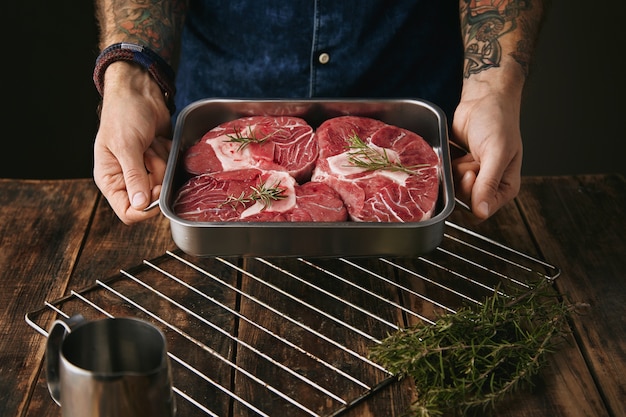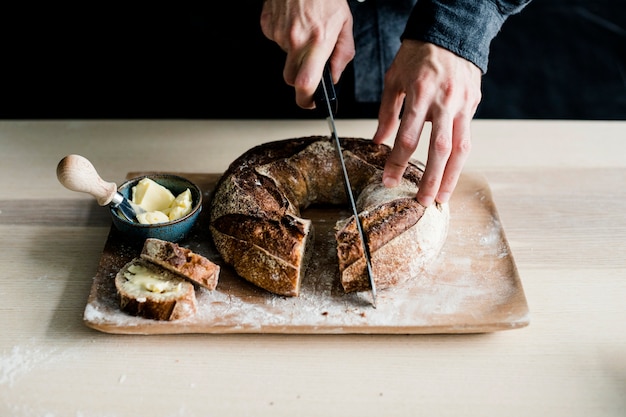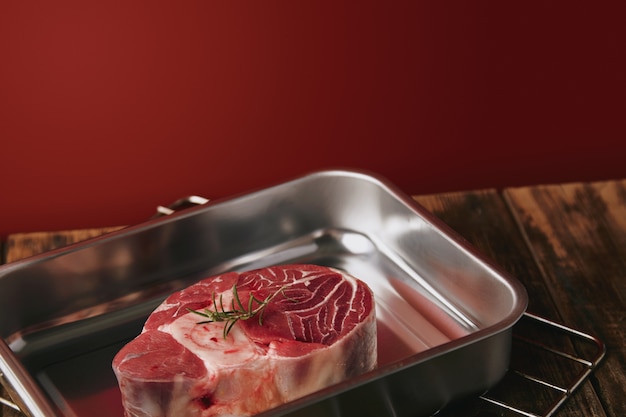There's a certain magic to a perfectly seared, juicy flank steak. It's a cut that’s bursting with flavour, but it can be a little tricky to tame. Getting that irresistible crust on the outside while keeping the inside tender requires a bit of finesse. Over the years, I've explored various cooking methods - from the classic cast iron to fancy sous vide techniques. But it was the humble stainless steel pan that truly unlocked the secrets of flank steak perfection for me.
I know what you're thinking: "Stainless steel? Isn't that just for boiling water?" But trust me, with the right approach, this unassuming pan can deliver sizzling, restaurant-quality steak right in your own kitchen. No fancy equipment, just a few essential tips and tricks.
So, grab your trusty stainless steel pan, pick out your favourite cut of flank steak, and let's embark on a journey to flavour town!
(Part 1) choosing the right cut

The Flank Steak: A Versatile Star
Let's start with the star of the show: the flank steak. This long, flat cut from the cow's belly is known for its rich flavour and distinctive marbling. It's not the most tender cut, but cooked properly, it becomes both juicy and flavourful. Flank steak is incredibly versatile too - it can be grilled, stir-fried, or even used in tacos. But for today, we're going to focus on the art of pan-searing.
The Beef: Quality Counts
Now, let's get a little discerning about our beef. I always recommend going for high-quality cuts, preferably grass-fed and organic. It might cost a bit more, but the difference in flavour is truly remarkable. If you can, ask your butcher for a piece that's about 1 inch thick – it's the perfect thickness for getting that beautiful crust without drying out the inside.
The Cuts: Flank vs Skirt
You'll often see flank steak and skirt steak listed together. They're similar, but there are some key differences. Flank steak is a bit thicker and more rectangular, while skirt steak is thinner and more curved. Both are excellent choices for this method, so go with whichever appeals to you.
(Part 2) Prep for Perfection

The Critical Trim
Once you've got your chosen flank steak, the first step is to trim off any excess fat. You don't want to remove all of it, as fat adds flavour. Just trim off any large pieces of fat that might burn in the pan. You can reserve the trimmings for making a delicious beef stock later!
Get the Grain Right
The key to a tender and juicy flank steak lies in understanding the grain. Think of it like the muscle fibers running along the steak. You want to cut across the grain – this makes the steak easier to chew and prevents it from becoming tough. Cut your steak into pieces about 1-2 inches wide, ensuring you're slicing across those muscle fibres.
Seasoning: The Secret Weapon
Now, let's talk seasoning. Simple is often best when it comes to flank steak. I love a good sprinkle of salt and pepper, plus a bit of paprika for a touch of colour and depth of flavour. You can also experiment with garlic powder, onion powder, or even a pinch of chili powder. Just remember, don't go overboard with the seasoning – we want to let the natural flavours of the steak shine through.
Here's a little tip: Let your steak sit at room temperature for about 30 minutes before cooking. This allows the steak to come to a more even temperature, resulting in a more evenly cooked steak.
(Part 3) The Stainless Steel Pan Power

Why Stainless Steel?
Now, let's talk about the magic of the stainless steel pan. It's the secret weapon for achieving that crispy, caramelised crust on the outside while keeping the inside juicy and tender. Here's why it's the best choice:
- Even Heating: Stainless steel heats up quickly and evenly, allowing for precise control over your cooking. This is crucial for getting that perfect sear.
- High Heat Tolerance: Stainless steel can withstand high heat, which is essential for searing. It won't warp or distort like some other pans.
- No-Stick Potential: While not completely non-stick, with proper heat management and a bit of oil, stainless steel can be quite good at preventing sticking. The key is to let the pan get really hot before adding the steak.
- Durability: Stainless steel is incredibly durable and can withstand years of use. It's also very easy to clean.
The Right Pan Size
I usually use a 12-inch stainless steel skillet for this. It's big enough to cook a good-sized flank steak without overcrowding it, but not so big that it takes forever to heat up. You want a pan that's heavy-bottomed to ensure even heat distribution.
The Essential Heat
Now, let's talk heat. This is where things get crucial. You want to sear your steak over high heat – think about your stovetop on high or medium-high. I usually let the pan heat up for about 5 minutes before adding the steak. You can tell it's ready when a drop of water sizzles and evaporates almost instantly. The pan should be smoking slightly.
(Part 4) Sealing In the Flavour
The First Sizzle
Once your pan is scorching hot, carefully add your seasoned flank steak pieces. Don't overcrowd the pan – you want enough space for them to brown evenly. Give them a quick sear on one side for about 2-3 minutes. You'll see a beautiful golden-brown crust developing. This creates a flavour barrier, trapping the juices inside.
The Flipping Technique
Now, here's the trick: flip your steak pieces over and sear on the other side for another 2-3 minutes. You're aiming for a nice, even crust on all sides. Don't be tempted to fiddle with them too much – let them cook undisturbed to develop that gorgeous char. You’ll know they’re ready to flip when the underside easily releases from the pan.
The Secret Ingredient: Fat
Now, for a little secret ingredient: add a tablespoon or two of butter to the pan. This helps to create a rich, caramelised flavour and adds a touch of moisture. As the butter melts, it will coat the steak, contributing to its beautiful browning and tenderisation.
(Part 5) The Finishing Touch
Rest and Release
After you've seared both sides, remove the flank steak from the pan and let it rest for 5-10 minutes. This allows the juices to redistribute, resulting in a tender, flavourful steak. Cover the steak loosely with foil to keep it warm.
The Delicious Reduction
While your steak is resting, you can create a delicious sauce from the pan drippings. Add a splash of red wine or beef broth to the pan, scraping up any browned bits. Simmer over medium heat for a few minutes, letting it reduce and thicken. This pan sauce is the perfect complement to your flank steak, adding a burst of flavour and richness.
(Part 6) Serving Up Perfection
Slicing for Tenderness
Finally, it's time to enjoy your perfectly cooked flank steak. Use a sharp knife to slice the steak against the grain, making it easier to chew. Arrange the slices on a platter and drizzle with the pan sauce. Serve with your favourite sides, such as mashed potatoes, roasted vegetables, or a simple salad.
(Part 7) FAQs: Answers to Your Questions
1. What if My Steak Is Too Thick?
If your flank steak is thicker than 1 inch, you might need to cook it for a little longer. Just keep an eye on it and adjust the cooking time as needed. A meat thermometer can come in handy to ensure the internal temperature reaches 130-135 degrees Fahrenheit for medium-rare. If the steak is too thick, you can also consider grilling it, which allows for more even cooking.
2. Can I Use a Different Pan?
While a stainless steel pan is ideal for this technique, you can also use a cast iron skillet or a well-seasoned carbon steel pan. Just make sure the pan is well-heated and use high heat for searing. These pans will create a slightly different flavour profile, but the overall result will be delicious.
3. What if My Steak Is Tough?
If your flank steak ends up tough, it might be due to overcooking. Next time, try cooking it for a shorter time and check the internal temperature with a meat thermometer. You can also try marinating the flank steak in advance to help tenderize it. Try a marinade with acidic ingredients like lemon juice or vinegar, as these can help break down the tough muscle fibers.
4. What Are Other side dishes I Can Serve?
Flank steak is so versatile! It pairs well with a variety of sides, including:
- Mashed potatoes
- Roasted vegetables (try Brussels sprouts, asparagus, or broccoli)
- grilled corn on the cob
- Arugula salad with a lemon vinaigrette
- rice pilaf
- black beans and rice
- Warm tortillas for a delicious taco night
5. Can I Make This Ahead of Time?
You can definitely prepare the flank steak ahead of time. Season it, then refrigerate it overnight. When you're ready to cook, let it come to room temperature before searing. You can also prepare the pan sauce in advance and reheat it when you're ready to serve. Just make sure to keep it warm in a saucepan over low heat.
(Part 8) Embrace the Experiment
The beauty of cooking is that it's a constant learning process. Don't be afraid to experiment with different seasonings, marinades, and side dishes. You might just discover your new favourite flank steak recipe! And remember, practice makes perfect. With each steak you cook, you'll gain more confidence and expertise. So grab that stainless steel pan, fire up the stovetop, and get ready to unlock the secrets of flank steak perfection!
Now that you've got the basics down, here's a little bonus for you - a few extra tips that can elevate your flank steak game even further:
- The Cold Pan Method: Some chefs swear by starting with a cold pan and bringing it up to temperature with the steak in it. This can help ensure the steak cooks evenly. Just make sure to use a high enough heat to create a good sear.
- Searing in Stages: If you're cooking a larger piece of flank steak, you can sear it in stages. Sear one side, then flip and sear the other side. Then, sear the edges of the steak. This will help ensure that the entire steak gets a nice crust.
- Pan Sauce Variations: Get creative with your pan sauce! Try adding a splash of soy sauce for a savory Asian-inspired twist, or a dollop of Dijon mustard for a tangy kick. You can even add a pinch of herbs like rosemary or thyme for an extra layer of flavor.
- Don't Overcook: One of the biggest mistakes people make with flank steak is overcooking it. Remember, it's a lean cut of meat, so it can dry out easily. Aim for medium-rare (130-135 degrees Fahrenheit) for the most tender and flavorful results. Use a meat thermometer to check the internal temperature if you're unsure.
So, go forth, conquer the art of flank steak, and impress your friends and family with your newfound skills. It's a culinary adventure waiting to be had!
Everyone is watching

Prime Rib Roast Cooking Time Chart: Per Pound Guide
Cooking TipsPrime rib roast. Just the name conjures images of lavish dinners, crackling fires, and hearty laughter. It’s ...

How Long to Bake Potatoes in the Oven (Perfect Every Time)
Cooking TipsBaked potatoes are a staple in my kitchen. They're incredibly versatile, delicious, and surprisingly easy to m...

Perfect Rice Every Time: The Ultimate Guide to Cooking Rice
Cooking TipsAs a self-proclaimed foodie, I've always been a bit obsessed with rice. It's the foundation of countless cuisi...

The Ultimate Guide to Cooking Asparagus: Tips, Techniques, and Recipes
Cooking TipsAsparagus. The mere mention of this spring delicacy conjures up images of vibrant green spears, crisp and burs...

Ultimate Guide to Cooking the Perfect Thanksgiving Turkey
Cooking TipsThanksgiving. Just the word conjures up images of overflowing tables laden with delicious food, the scent of r...
